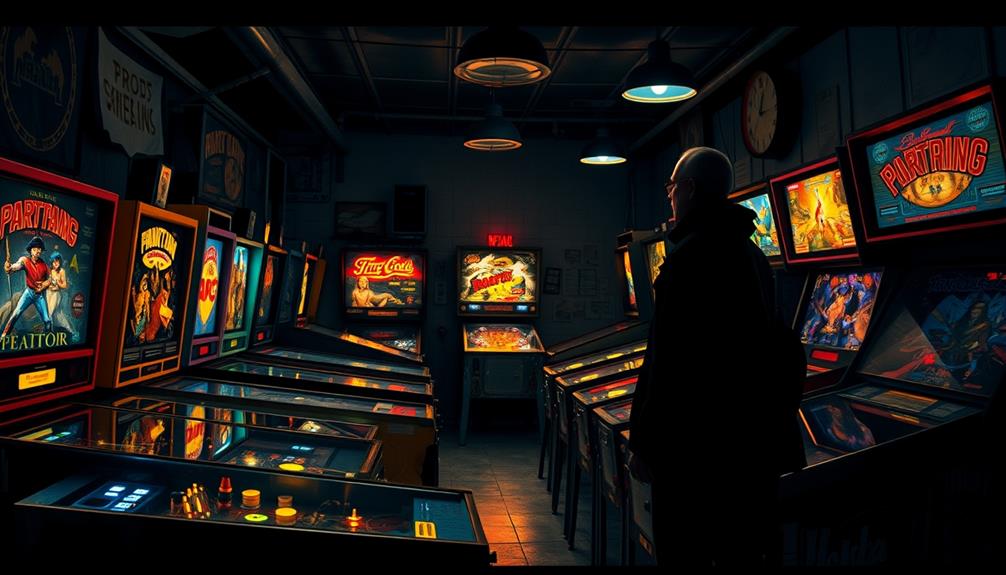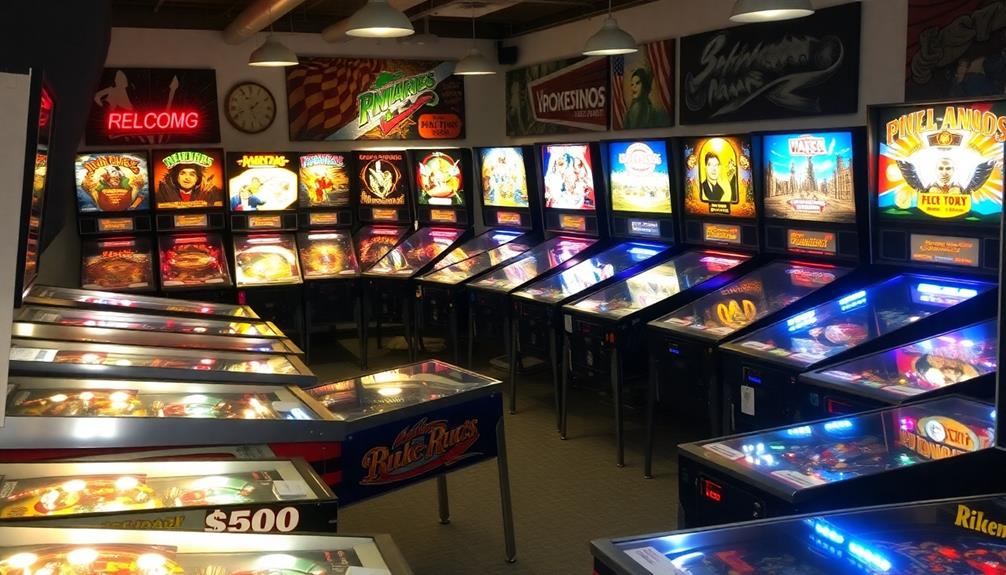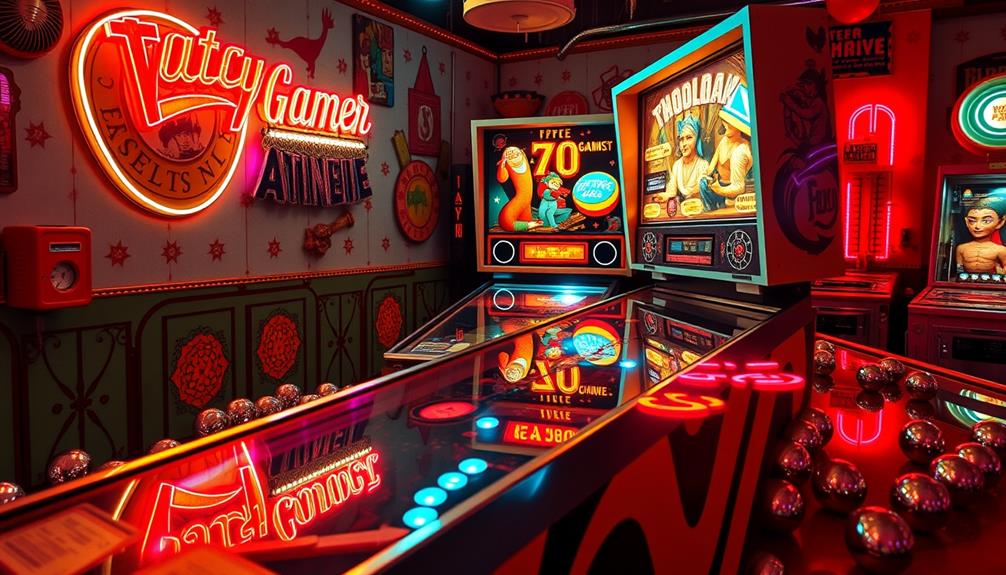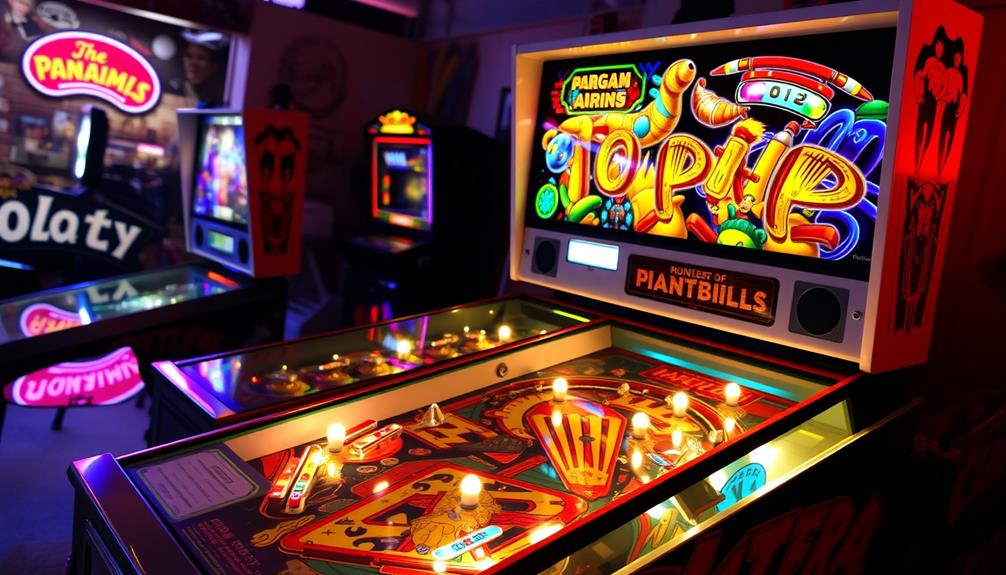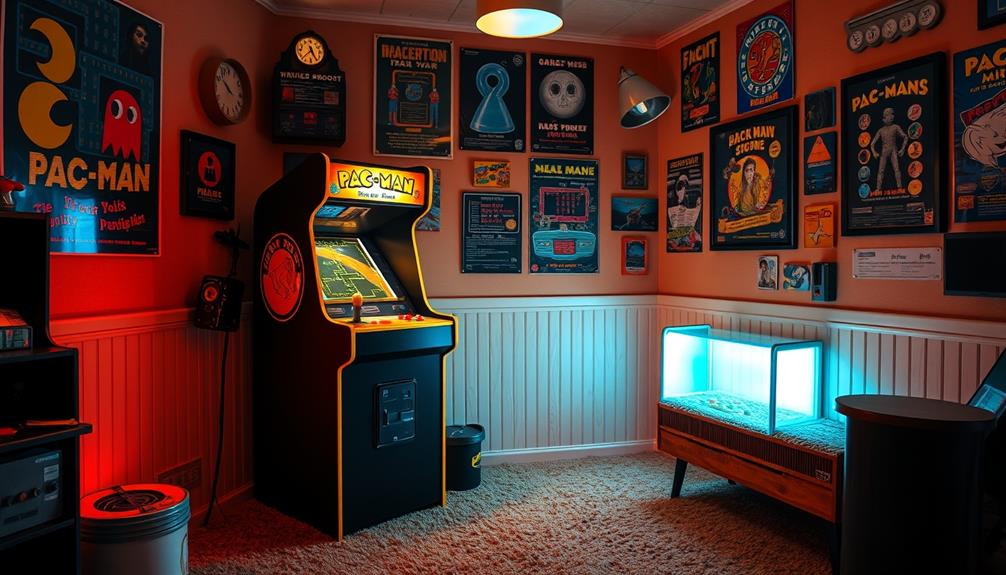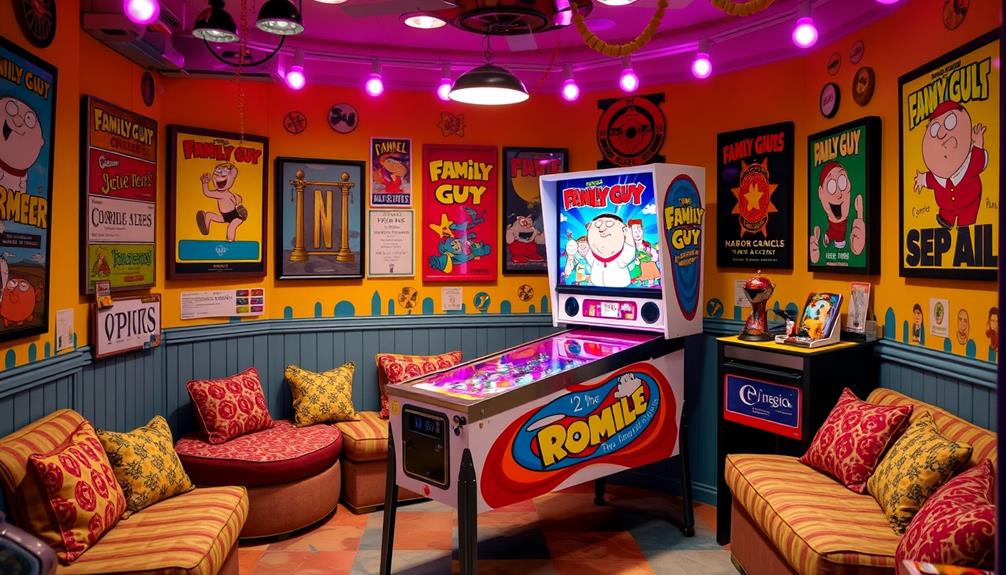The pinball machine was invented as a way to provide affordable entertainment during tough times, especially the Great Depression. It evolved from earlier games like Bagatelle, combining luck and skill to lure players. With the introduction of coin-operated designs, pinball became accessible to many, transforming social spaces like bars and arcades into lively venues for fun. Over the decades, technological advancements kept pinball fresh and exciting, adding elements like flippers and digital screens. This enduring appeal not only captivated generations but also shaped gaming culture as a whole. You might find the next part of its journey intriguing too. The history of pinball machines is a fascinating story of innovation and adaptation. From the early days of bagatelle to the modern, high-tech machines found in arcades today, pinball has continuously evolved to capture the imagination of players. The continued popularity of pinball machines demonstrates their enduring appeal and the enduring legacy of the game.
Key Takeaways
- Pinball machines were invented to provide affordable entertainment during the Great Depression, offering a social escape for players.
- The incorporation of coin-operated designs made pinball accessible to a wider audience, enhancing its popularity.
- The game evolved from Bagatelle, utilizing similar mechanics to engage players in a fun, competitive environment.
- Technological advancements, such as electrically powered machines and flippers, transformed gameplay, making it more skill-based and appealing.
- Pinball's invention was also influenced by gambling associations, leading to the redefinition of the game as a skill-based activity to circumvent legal restrictions.
Origins of Pinball
The fascinating evolution of pinball reveals a rich history rooted in the late 18th century. It all began with the French game known as bagatelle, where players used a cue stick to hit balls into scoring holes past wooden pins. This laid the groundwork for what we now know as pinball.
In 1871, Montague Redgrave patented an improved version of bagatelle, introducing a coiled spring and plunger mechanism that enhanced gameplay. This innovation set the stage for future developments in the history of pinball. Additionally, the importance of engaging gameplay mechanics can be likened to how modern best vacuums for dust removal are designed to enhance cleaning efficiency.
Fast forward to 1931, when Raymond Maloney created the first modern coin-operated pinball machine, Ballyhoo. This marked a significant shift from bagatelle to a more structured pinball experience.
Initially, early pinball machines relied heavily on chance and lacked flippers, making skill-based play nearly impossible. However, in 1947, the introduction of player-controlled flippers transformed the game, allowing you to exert more control and strategy.
As pinball gained popularity during the Great Depression, the term "pinball" was officially coined in 1936, solidifying its identity and paving the way for its future as a beloved form of entertainment.
Early Coin-Operated Machines

In the early 1930s, a revolutionary shift occurred in the domain of gaming with the introduction of coin-operated pinball machines. Raymond Maloney's invention of the first coin-operated pinball game, Ballyhoo, in 1931 marked a significant milestone for the pinball industry. During the Great Depression, early coin-operated machines like Baffle Ball made gaming an affordable form of entertainment, allowing players to enjoy multiple rounds for just a penny.
| Machine Name | Year Introduced |
|---|---|
| Ballyhoo | 1931 |
| Baffle Ball | 1931 |
| Whiffle Board | Early 1930s |
| Genco 1 | 1936 |
| Pinball | 1936 (term) |
These early machines featured engaging gameplay mechanics that combined luck and skill, enchanting a wide range of players. The popularity of these coin-operated games laid the foundation for the arcade culture of the 1930s, making pinball a beloved pastime. As you explore this era, you'll see how the innovations in coin-operated machines shaped the future of entertainment, transforming pinball into a cultural phenomenon.
The Influence of Bagatelle

Drawing from the rich history of gaming, Bagatelle played an essential role in shaping the evolution of pinball machines. This late 18th-century French parlor game involved players using a cue stick to propel balls into scoring pockets, providing the foundational mechanics that inspired later designs.
As Bagatelle evolved, innovative features like inclined tables and coiled springs emerged, allowing for more controlled ball launching and setting the stage for modern pinball. The concept of budget management can be likened to the strategic planning involved in scoring in Bagatelle, where players must carefully consider their moves.
In 1871, Montague Redgrave patented an improved version of Bagatelle, introducing a plunger mechanism and smaller marbles. This innovation marked a significant shift toward coin-operated pinball machines.
The first modern coin-operated pinball machine, Ballyhoo, emerged in 1931, drawing heavily from the mechanics and rules of Bagatelle.
Technological Innovations Over Time

Bagatelle laid the groundwork for pinball's evolution, but it was technological innovations that truly transformed the game. The first electrically powered pinball machines emerged in 1933, introducing electromechanical bells and buzzers that enhanced the gaming experience. This shift not only improved gameplay but also increased user retention, reflecting the importance of content relevance and authority in engaging players.
In 1947, the game "Humpty Dumpty" introduced flippers, which revolutionized gameplay by giving you more control over the ball. This marked a significant shift toward skill-based play.
As the late 1970s rolled in, solid-state technology took center stage, powered by microprocessors that enabled complex game rules, digital sound effects, and multi-level playfields. This advancement allowed for a richer gaming experience that kept players engaged.
Fast-forward to 1998, when the first pinball machine featuring a video screen hit the market, merging traditional gameplay with digital elements.
Today, innovative designs continue to push boundaries. Machines like "Jurassic Park" and "The Wizard of Oz" incorporate animatronics and LCD screens, providing immersive themes and interactive gameplay experiences.
Each technological advancement hasn't only enhanced gameplay but also guaranteed that pinball remains a dynamic and enthralling pastime for players.
Cultural Significance and Popularity

Pinball machines took off during the Great Depression, offering an affordable escape for people facing economic challenges. They became a source of entertainment that anyone could enjoy, helping to lift spirits during tough times.
As an engaging form of play, pinball machines provided a break from daily struggles and were often found in bars and other social venues, contributing to their widespread appeal.
The introduction of flippers in the late 1940s changed the game, turning pinball from pure chance into a test of skill. This innovation dramatically increased their popularity in arcades, making them a staple of gaming culture and a part of the best websites to earn money online through arcade businesses.
Challenges and Declines

You might be surprised to learn that pinball machines faced serious challenges due to their gambling associations, which led many cities to ban them in the 1940s.
This legal scrutiny echoed the moral implications of actions, similar to the discussions surrounding utilitarian thinkers' declarations on ethical decision-making.
As video games took over in the 1980s, pinball's market share plummeted, making it tough for manufacturers to stay afloat.
The combination of legal issues and fierce competition pushed the once-thriving industry into a steep decline.
Gambling Associations Impact
In the 1940s, numerous cities, including New York, banned pinball machines, viewing them as illegal gambling devices. These gambling associations labeled them as purely chance-based games, leading to strict legal restrictions that devastated the pinball industry.
As AI technologies began to emerge, the conversation around gaming and interactivity shifted, emphasizing the importance of skill and engagement in games, similar to how AI-Powered Virtual Reality in E-Learning is transforming education. During this period, many manufacturers faced a sharp decline in machine sales and production. Companies like Bally struggled financially, ultimately forced to sell divisions just to survive.
However, a turning point came in 1974 when the California Supreme Court ruled that pinball was a game of skill rather than chance. This landmark decision helped reverse some of the bans, allowing pinball machines to thrive again in various jurisdictions.
The resurgence of pinball in the mid-1970s was largely driven by the introduction of flippers, which enhanced the skill-based nature of the game. This innovation helped distance pinball from its gambling associations, attracting a broader audience.
While the impact of gambling associations and subsequent bans posed significant challenges, the industry's adaptability led to renewed growth. By redefining pinball as a skill-based game, the industry not only survived but also laid the groundwork for future innovations.
Video Game Competition
Competing against the rise of arcade video games in the late 1970s and early 1980s, pinball machines faced a dramatic decline in popularity. As gamers flocked to iconic titles like Pac-Man and Donkey Kong, pinball sales dropped an astonishing 85% after 1982. The peak of 200,000 units sold in 1979 plummeted to fewer than 4,000 by the late 1990s.
This shift marked a significant challenge for the industry, as the competition from home gaming consoles and digital gaming took center stage. Additionally, the evolving entertainment landscape, including luxury cruise experiences, provided alternative leisure activities that further diverted attention from traditional gaming.
While notable pinball games like Williams' High Speed and Space Shuttle emerged in the mid-1980s to spark a revival of interest, they struggled against the allure of video games in arcades. Ultimately, Williams closed its pinball division in 1999, unable to compete with the dominance of digital entertainment.
However, the early 2000s brought a resurgence, thanks to independent manufacturers like Jersey Jack Pinball and Spooky Pinball. They introduced modern pinball machines featuring innovative technology, helping to breathe new life into a beloved pastime that once thrived during the Golden Age.
Modern Resurgence and Future

You've probably noticed how pinball's making a comeback, thanks to innovative machines from boutique manufacturers and the integration of advanced technology like LCD screens.
This cultural revival isn't just about nostalgia; it's also creating social hubs in arcade bars and pinball museums, drawing in both enthusiasts and newcomers.
Recent trends highlight the importance of community engagement, much like how celebrities design their retreats to foster social connections.
As competitive tournaments grow in popularity, it's clear that pinball's future is bright and engaging.
Technological Innovations Today
The modern pinball machine has transformed into a high-tech marvel, enchanting players with its vibrant LCD screens, interactive elements, and even animatronics. These advanced technologies enhance gameplay, making every session a unique experience.
As highlighted in design thinking's emphasis on innovation, themed machines based on popular franchises bridge the gap between nostalgia and contemporary culture, appealing to both seasoned players and newcomers alike.
Thanks to smaller companies like Jersey Jack Pinball, Spooky Pinball, and American Pinball, innovation in the pinball market is thriving. These manufacturers aren't only pushing the envelope with creative designs but are also focusing on sustainability.
They're exploring eco-friendly materials and practices in production, ensuring that pinball machines are as responsible as they're entertaining.
Moreover, the resurgence of pinball has led to a surge in events like tournaments and conventions. These gatherings foster community engagement, attracting a diverse group of players enthusiastic to share their passion.
As you immerse yourself in this world of modern pinball machines, you'll find that the blend of nostalgia, advanced technologies, and commitment to sustainability creates a vibrant future for this beloved pastime.
Cultural Revival Impact
Pinball's cultural revival is reshaping social spaces and gaming communities, breathing new life into this classic pastime. The modern resurgence of pinball is evident in the rise of arcade museums and bars, where people gather to relive nostalgic memories and engage with one another. These venues foster community engagement, making pinball more than just a game—it's a social experience.
This trend mirrors the growing popularity of Nike Tech in sneaker culture, where modern consumers seek comfort and style through innovative designs that enhance their social interactions.
Pinball tournaments and leagues have gained popularity, attracting a diverse audience enthusiastic to showcase their skills and strategies. With advanced technology and unique themes, today's machines appeal to younger generations, bridging the gap between retro gaming and contemporary entertainment.
Independent manufacturers like Jersey Jack Pinball and Spooky Pinball have emerged, introducing innovative designs that excite both collectors and casual players.
This growing trend highlights the cultural significance of pinball machines, which remain timeless icons in the gaming landscape. As you explore this revitalized world, you'll find that pinball isn't just about the gameplay; it's a celebration of community, competition, and shared nostalgia.
The future looks bright for this classic pastime, as it continues to evolve and captivate new audiences.
Frequently Asked Questions
What Is the Purpose of a Pinball Machine?
The purpose of a pinball machine is to entertain you by challenging your skills and reflexes. You launch a metal ball, use flippers, and aim for targets, creating excitement and competition with each game. Pinball machines have a long and fascinating history, evolving from simple bagatelle games in the 18th century to the modern electronic machines we see today. The history of pinball machines is filled with innovation and creativity, as designers constantly sought to improve gameplay and enhance the experience for players. Today, pinball machines continue to be enjoyed by people of all ages, bringing a nostalgic sense of fun and excitement to arcades, bars, and homes around the world.
What Is Pinball and Why Was It Illegal?
Pinball's a fast-paced game where you launch steel balls to score points. It was illegal in many places because it was viewed as a game of chance, often associated with gambling, not skill.
How Did Montague Redgrave Come up With the Pinball Game?
You'll find Montague Redgrave's inspiration stemmed from traditional bagatelle games. He envisioned a more engaging experience, developing a spring-loaded mechanism and inclined table that challenged players to score while avoiding pins. This innovation changed gaming forever.
What Is the Story of Pinball Game?
The story of the pinball game begins in the early 1930s, evolving from bagatelle. You'll see its transformation with the introduction of flippers in 1947, enhancing skill-based play and enchanting players for decades.
Conclusion
In the end, the invention of the pinball machine reflects our endless pursuit of fun and challenge. Just as a pinball ricochets through a maze of obstacles, so too has this game bounced through history, adapting and evolving with each twist and turn. Today, it stands not just as a nostalgic relic but as a vibrant part of our culture. So, why not embrace the thrill? After all, life's a game—why not play it with a little flair?


